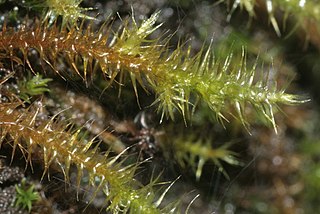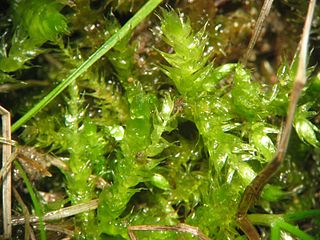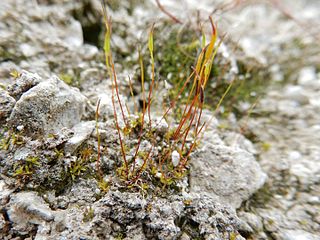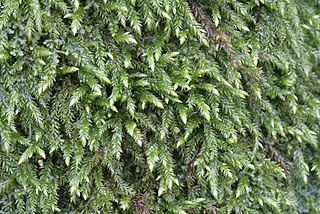
Thamnobryum is a genus of moss in the family Neckeraceae. There are about 50 species. The genus is distributed throughout the world.

Calliergon is a genus of moss in the order Hypnales. The species in the genus are commonly referred to as calliergon mosses.

Ditrichum is a genus of haplolepideous mosses (Dicranidae) in the family Ditrichaceae.

Amblystegiaceae is a family of mosses. It includes 20 to 30 genera with a total of up to 150 species. They occur nearly worldwide, growing in tropical, temperate, and subpolar regions.

Brachytheciaceae is a family of mosses from the order Hypnales. The family includes over 40 genera and 250 species.

Thuidium is a genus of moss in the family Thuidiaceae. The name comes from the genus Thuja and the Latin suffix -idium, meaning diminutive. This is due to its resemblance to small cedar trees.
Campylidium is a genus of mosses belonging to the family Amblystegiaceae.

Aloina is a genus of mosses belonging to the family Pottiaceae first described by Nils Conrad Kindberg. It has a cosmopolitan distribution.

Rhynchostegium is a genus of pleurocarpous mosses belonging to the family Brachytheciaceae. The genus has a cosmopolitan distribution across different climatological regions except the polar regions, mostly in tropic to north temperate regions. The genus contains both aquatic and terrestrial species. The genus was named for their rostrate opercula. The type species of this genus is Rhynchostegium confertum (Dicks.) Schimp.
Campylium is a genus of mosses belonging to the family Amblystegiaceae.

Antitrichia is a genus of mosses belonging to the family Leucodontaceae with a cosmopolitan distribution.

Ceratodon is a genus of mosses belonging to the family Ditrichaceae. The genus was first described by Samuel Elisée Bridel-Brideri and has a cosmopolitan distribution.

Isothecium is a genus of mosses belonging to the family Lembophyllaceae. The genus has a cosmopolitan distribution.

Bestia is a genus of mosses belonging to the family Lembophyllaceae.
Pleurozium is a genus of mosses belonging to the family Hylocomiaceae.
Platygyrium is a genus of mosses belonging to the family Hypnaceae.
Dichelyma is a genus of mosses belonging to the family Fontinalaceae.
Heterophyllium is a genus of mosses belonging to the family Sematophyllaceae.
Heterocladium is a genus of mosses belonging to the family Thuidiaceae.

Leskeaceae is a family of mosses belonging to the order Hypnales.













